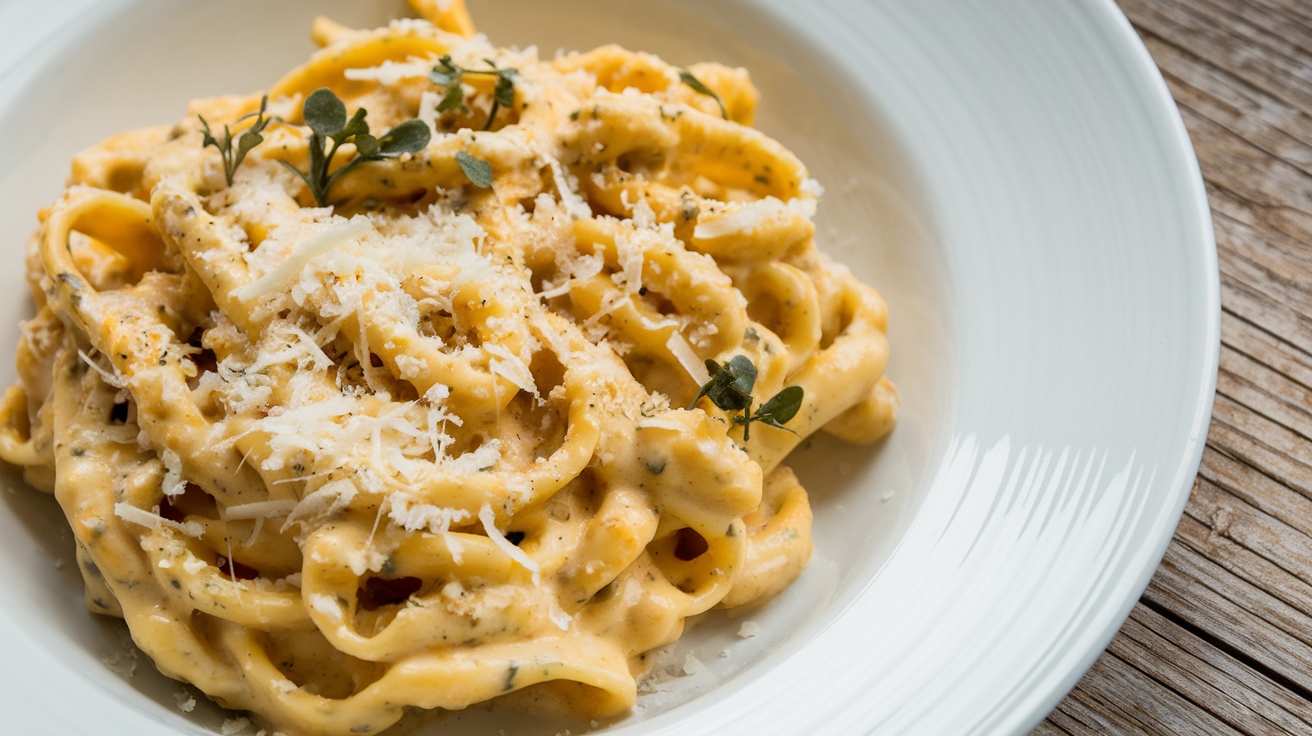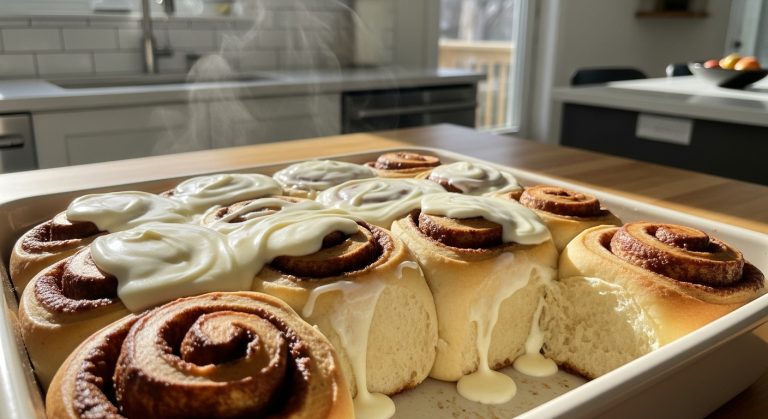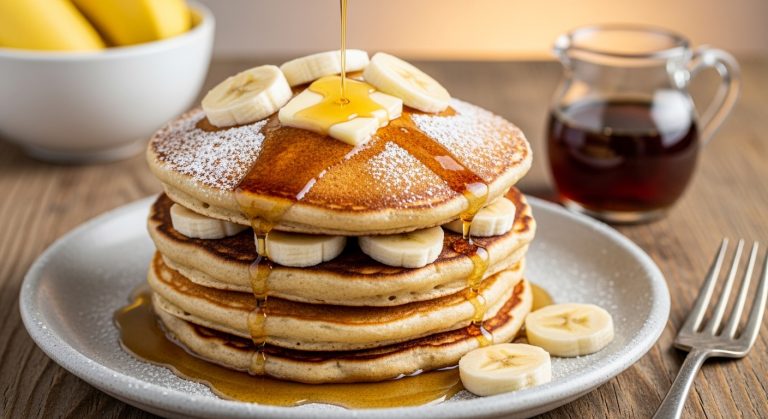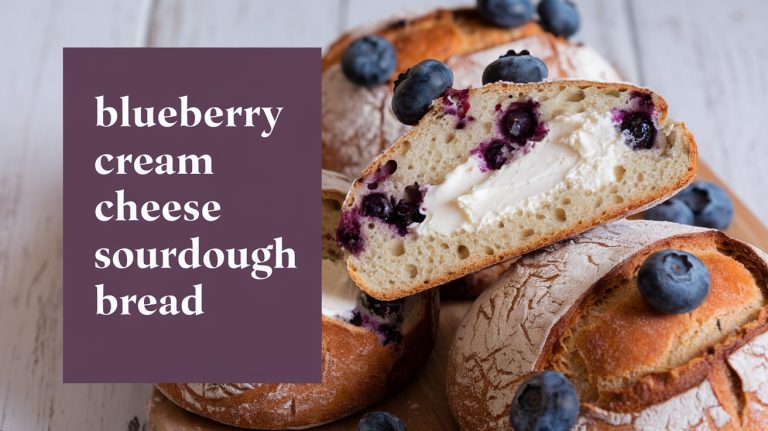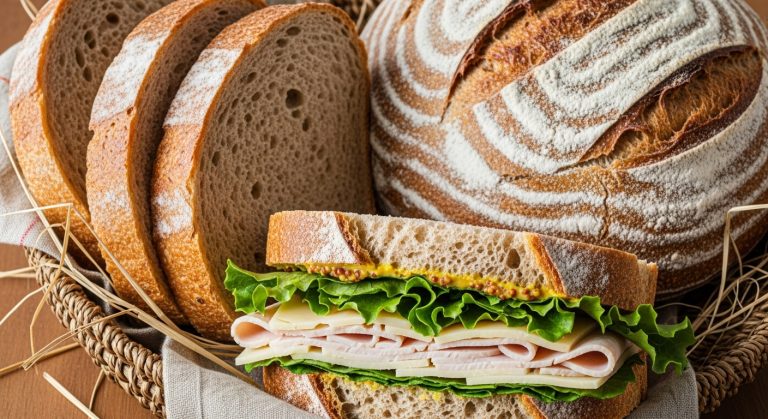Sourdough Discard Pasta Recipe: A Nutritious, Zero-Waste Delight
Using sourdough discard to make pasta is a brilliant way to reduce waste while creating something delicious. Combine 1 cup of your discard, 3 cups of all-purpose flour, and 4 eggs to form a dough.
Knead it for about ten minutes, let it rest, and then roll it out to your desired thickness. Cook your fresh pasta in boiling salted water for just a few minutes.
The result? A uniquely flavored, nutritious meal that’s easy to prepare.
With countless options for flavor variations and techniques, your pasta-making journey is just getting started. Explore the endless possibilities waiting for you.
Key Takeaways
- Combine 1 cup of sourdough starter, 3 cups of flour, and 4 eggs in a mixing bowl to create the pasta dough.
- Knead the dough for 8-10 minutes by hand or 7-8 minutes using a stand mixer, then let it rest for 30 minutes.
- Roll the rested dough to 1/8 inch thick for spaghetti or 1/16 inch for lasagna, ensuring even thickness.
- Cook fresh pasta in boiling salted water for 2-7 minutes, testing for doneness by tasting or checking if it floats.
- Store uncooked pasta in the refrigerator for up to 2 days or freeze in a single layer for up to 2 months.
What Is Sourdough Pasta?
Sourdough pasta is a delightful twist on traditional pasta, combining the tangy essence of sourdough starter with quality flour and eggs to create a unique dish. This recipe utilizes sourdough discard, allowing you to minimize waste while crafting fresh pasta.
The fermentation process not only enhances the flavor but also improves gluten digestibility, making it easier on your gut compared to conventional pasta. By incorporating discarding sourdough starter, you guarantee a balanced microbial culture that adds richness to your pasta.
You can prepare sourdough pasta in two ways: a quick method that yields a mild sourdough flavor in about an hour or a longer fermentation method that develops deeper flavors over 24 hours. The choice is yours!
When it comes to cooking, fresh sourdough pasta cooks faster than dried options, typically taking only 2-7 minutes to achieve that perfect al dente texture.
Nutritionally, a serving of sourdough pasta contains around 280 calories, offering a balanced profile of carbohydrates, protein, and minimal fat. This makes it a wholesome choice for your meals.
Ingredients and Equipment Needed
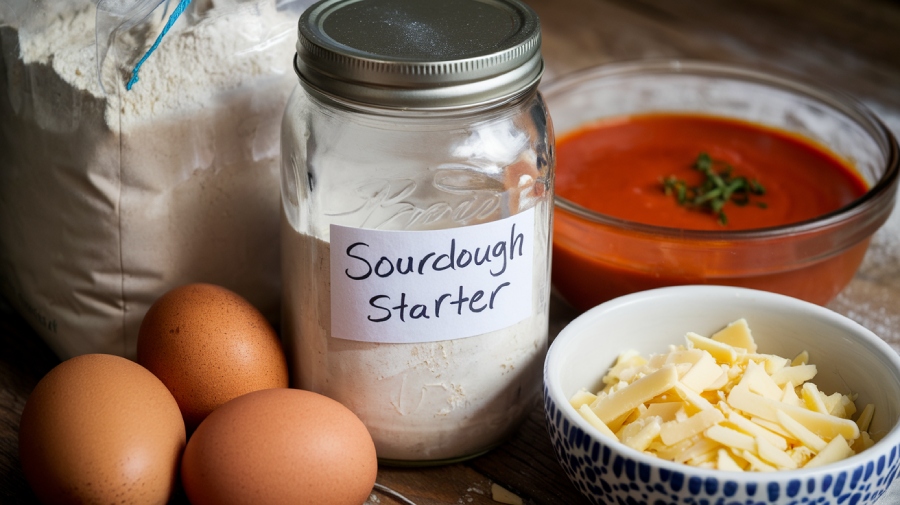
To whip up a delicious batch of sourdough discard pasta, you’ll need a few key ingredients and some essential equipment. Start with these basics to create a mouthwatering dish you’ll be proud of:
- 1 cup of sourdough starter – Use either discard or fed for that distinct tang.
- 3 cups of all-purpose flour – This forms the backbone of your pasta.
- 4 large eggs – Go for pasture-raised for the best flavor and nutrition.
Once you’ve gathered these ingredients, you’ll need some handy tools to bring your pasta to life. Mixing bowls are essential for combining your ingredients, while a dough hook is a game-changer if you’re using a stand mixer.
You’ll also want a rolling pin or a pasta roller to get that perfect thickness. A bench scraper will help you cut the pasta into your desired shapes, and don’t forget a pasta drying rack to hang your creations and prevent sticking.
If you plan on dusting your work surface, keep some additional flour handy.
Sourdough Pasta Dough Prep
Making sourdough pasta dough is a straightforward yet rewarding process that yields delicious results. To get started, combine 1 cup of sourdough starter, 3 cups of flour—preferably Italian 00 or all-purpose—and 4 large eggs in a mixing bowl.
Knead the dough by hand for about 8-10 minutes until it’s smooth and elastic, or use a stand mixer with a dough hook for approximately 7-8 minutes.
Once you’ve kneaded the dough, wrap it in plastic wrap and let it rest at room temperature for at least 30 minutes. This rest period is essential as it relaxes the gluten, making it easier to roll the dough later.
For enhanced flavor and texture, consider letting the dough ferment in the refrigerator for up to 24 hours.
When you’re ready to roll the dough, sprinkle additional flour as needed to prevent sticking. Aim for a thin consistency that suits your desired pasta shape.
Rolling and Cutting Techniques
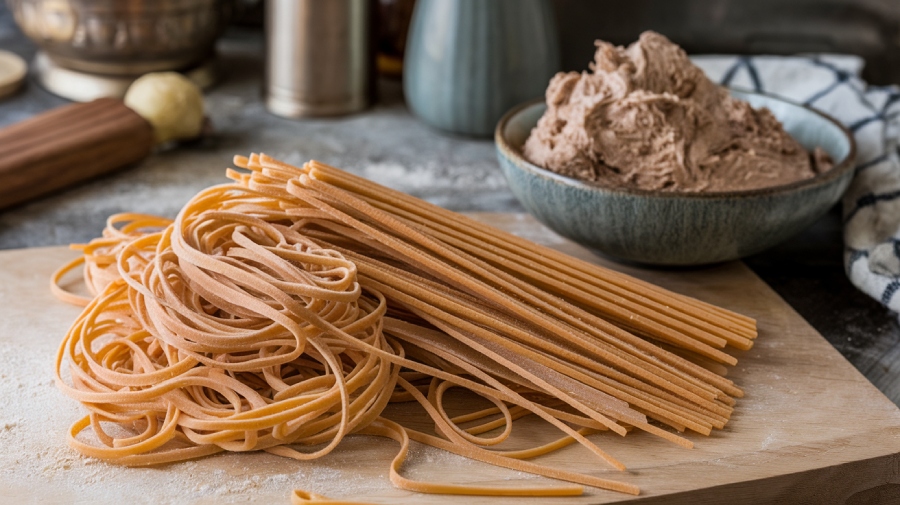
Now that you’ve got your sourdough pasta dough ready, it’s time to roll and cut it into perfect shapes.
Start by dividing the dough into manageable portions, ensuring you achieve that ideal thickness for your desired pasta type.
Dough Preparation Steps
Rolling and cutting your sourdough pasta is where the magic truly happens, transforming your dough into delicious shapes ready for cooking.
To start, divide your sourdough pasta dough into smaller portions. Use a rolling pin or pasta machine to roll each piece out to about 1/8 inch thick for spaghetti or 1/16 inch for lasagna sheets. Remember to dust with flour to prevent sticking.
If your dough shrinks during the rolling process, don’t fret! Just let it rest for a few minutes before continuing.
Here are three essential steps for perfect pasta preparation:
- Achieve the Right Thickness: Aim for a consistent thickness throughout to guarantee even cooking.
- Cut with Precision: Use a pizza cutter or sharp knife to cut pasta into desired shapes, ensuring uniform sizes.
- Allow to Dry: Let the cut pasta dry for at least 30 minutes on a floured surface or pasta drying rack to enhance texture and prevent sticking.
Once you’re ready to cook sourdough, remember that fresh homemade pasta typically takes only 2-5 minutes to reach al dente perfection.
Cutting Methods Explained
Often, the art of cutting pasta is just as important as the rolling process itself, as it defines the final shape and texture of your dish. After rolling your sourdough discard pasta dough to a thin, even thickness—around 1/16 to 1/8 inch—use a rolling pin or a pasta machine, making certain you dust with flour to prevent sticking.
Now, it’s time to employ your cutting methods. Grab a sharp knife or a pizza cutter to slice the rolled dough into your desired shapes, whether you’re making fettuccine or pappardelle. This is where your creativity shines!
Once you’ve cut the pasta strands, let them rest for 30 minutes. This drying time helps prevent sticking during cooking. If you’re crafting ravioli, consider using a mold or stamp to create uniform pieces; just make sure you seal them well around the filling.
To further reduce sticking, dust all cut pasta with semolina flour and arrange it loosely on a tray for best air circulation before cooking.
Cooking Fresh Sourdough Pasta
Cooking fresh sourdough pasta is a delightful experience that brings out the unique tang of the sourdough starter. You’ll love how quickly it cooks in boiling salted water—just 2 to 7 minutes, depending on its thickness. The key to perfection? Aim for that al dente texture!
Here are three tips to elevate your pasta cooking game:
- Test for doneness: Fresh pasta typically floats to the surface when ready, but tasting a strand guarantees it’s just right.
- Use tongs: When your pasta is done, grab it with tongs and transfer it directly into your sauce. This helps retain pasta water, enhancing flavor and texture.
- Combine sauces immediately: Toss your freshly cooked pasta with sauces like brown butter or pesto right away to prevent sticking and to maximize flavor.
If you’ve got leftovers, you can refrigerate fresh sourdough pasta for up to 2 days. For longer storage, dry it for 15-20 minutes, then freeze in zip-top bags for up to a month.
Storing and Freezing Pasta
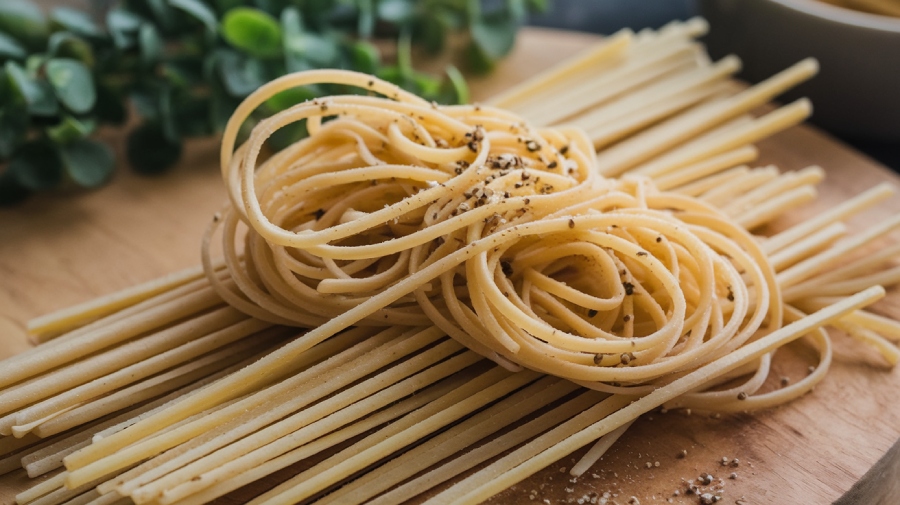
Storing and freezing your sourdough pasta properly guarantees you can enjoy its delightful flavor even after your cooking session. To keep your uncooked pasta fresh, simply cover it tightly and refrigerate for up to 2 days. If you want to store it longer, dust the uncooked pasta with flour, lay it out in a single layer, and freeze for about an hour. After that, transfer it to an airtight container or zip-top bag for up to 8 months.
For dried pasta, hang it for 24 hours to verify it’s completely dry before placing it in airtight containers, where it’ll last for up to 2 months without losing quality. When it comes to cooked pasta leftovers, store them in an airtight container in the fridge and consume within 3-4 days for prime freshness and safety.
Here’s a quick reference table for your convenience:
| Storage Method | Duration |
|---|---|
| Fresh Sourdough Pasta | Up to 2 days |
| Frozen Uncooked Pasta | Up to 8 months |
| Dried Pasta | Up to 2 months |
| Cooked Pasta Leftovers | 3-4 days |
Flavor Variations to Try
There’s no limit to the delicious flavor variations you can create with sourdough pasta. By incorporating different ingredients, you can elevate your pasta dough beyond traditional sourdough pasta. For instance, you can utilize leftover sourdough starter to minimize waste while crafting a delightful dish, similar to sourdough discard cheese crackers.
Here are some exciting options to ponder:
- Fresh Herbs: Mix in fragrant fresh herbs like basil, parsley, or chives for a vibrant and aromatic twist that enhances your pasta’s flavor.
- Vegetable Purees: Add colorful vegetable purees, such as spinach or beetroot, to not only boost the visual appeal but also infuse your pasta with health benefits.
- Cheese and Spices: Blend in finely grated cheese, like Parmesan or Pecorino, along with spices such as garlic powder or paprika, creating unique flavor profiles that pair beautifully with your favorite sauces.
For an extra layer of flavor, contemplate using flavored oils like truffle or chili oil instead of olive oil when preparing your dough.
Troubleshooting Common Issues
When diving into the world of sourdough discard pasta, you might encounter a few common issues that can impact your culinary experience. Don’t worry; troubleshooting is part of the fun! Here are some tips to guide you:
| Issue | Solution |
|---|---|
| Dough too dry or crumbly | Gradually add water or olive oil to achieve the desired consistency. |
| Pasta sticking together | Use additional flour to prevent sticking and guarantee a cool surface when rolling out the pasta. |
| Uneven cooking | Roll out the pasta to a consistent thickness—1/8 inch for spaghetti or 1/4 inch for fettuccine. |
| Overcooked pasta | Monitor the cooking time closely; fresh pasta cooks in just 2-7 minutes. |
If you’re concerned about flavor, let the dough rest for longer, ideally up to 24 hours. This allows time for fermentation to enhance flavor, giving your sourdough discard pasta a delightful tang.
Benefits of Sourdough Pasta
When you choose sourdough pasta, you’re not just enjoying a delicious meal; you’re also boosting your digestion and nutrition.
The fermentation process enhances the flavors, allowing you to get creative with unique variations while minimizing waste by using sourdough discard.
Plus, you’ll feel great knowing you’re making a healthier choice that supports your well-being.
Enhanced Digestibility and Nutrition
Fermentation brings a remarkable transformation to pasta, particularly in sourdough varieties. When you use sourdough discard, the fermentation process enhances the digestibility of gluten, making it gentler on your gut compared to conventional pasta. The natural acids and bacteria present in sourdough break down hard-to-digest enzymes, helping to reduce bloating and improve nutrient absorption.
Additionally, the fermentation process increases the bioavailability of essential minerals like iron and zinc, further elevating the nutritional benefits of your meal, as sourdough fermentation enhances nutrient absorption.
Not only does this process maximize the nutritional content of the pasta, but it also guarantees you’re getting essential vitamins and minerals like potassium and iron. With a serving of sourdough pasta containing about 280 calories, it strikes a great balance between carbohydrates and protein, making it a nutritious choice for any meal.
Moreover, sourdough pasta cooks faster than traditional options, typically ready in just 2-5 minutes. This quick cooking means that more nutrients are retained during the process, delivering a wholesome dish that’s both satisfying and beneficial.
Flavor Variations and Creativity
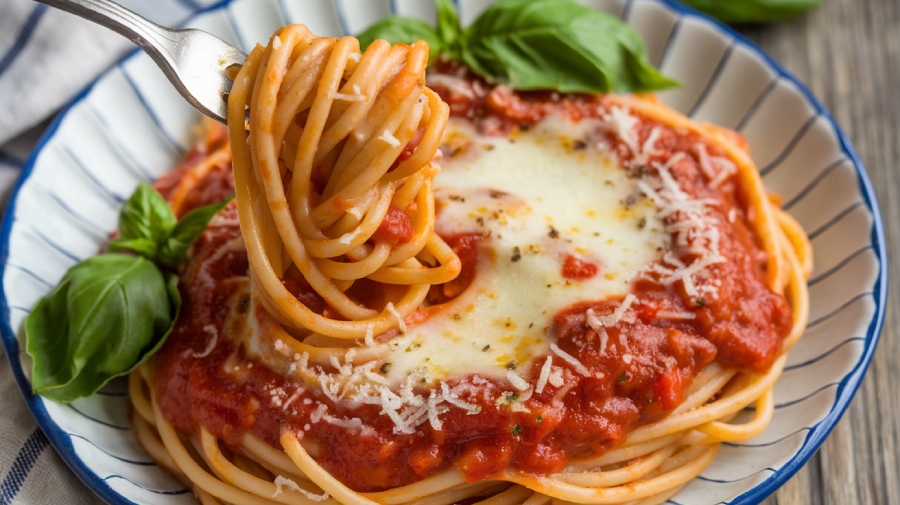
Elevate your culinary creations with sourdough pasta by exploring a world of flavor variations and creative enhancements. Using sourdough discard as your base, you can infuse your pasta with fresh herbs such as chives or thyme, adding a unique taste profile that’ll tantalize your taste buds.
The addition of sourdough not only enhances flavor but also improves digestibility and nutritional value compared to conventional pasta, making it a healthier choice for your meals utilizing leftover sourdough starter.
For a feast for the eyes, embrace natural colorants like beetroot or spinach juice, creating vibrant hues that transform your dish into a visual masterpiece.
Spices, like saffron, not only deepen the flavor but also lend a rich golden color, enhancing the overall presentation.
Don’t shy away from experimenting with vegetable purees, such as sweet potato or carrot. These additions not only boost nutrition but also impart a subtle sweetness, making your pasta a well-rounded delight.
Waste Reduction Through Discard
Exploring creative flavors in your sourdough pasta not only adds excitement to your meals but also plays a significant role in reducing food waste. By repurposing sourdough discard, you’re turning what would typically be thrown away into a delicious meal option.
Each batch of sourdough pasta can use about 1 cup of discard, effectively diverting waste and contributing to a more sustainable kitchen practice. This method of utilizing sourdough not only enhances the flavor profile but also aligns with transforming kitchen waste into delightful dishes.
Sourdough pasta isn’t just about flavor; it also brings nutritional benefits. The discard contains active enzymes and probiotics that can aid digestion, making your meal not only tasty but also healthier.
Frequently Asked Questions
Can I Use Whole Wheat Flour Instead of All-Purpose Flour?
Absolutely, you can use whole wheat flour instead of all-purpose flour!
Whole wheat flour adds a nutty flavor and a heartier texture to your dishes. Just keep in mind that it absorbs more liquid, so you might need to adjust your recipe accordingly.
Start by substituting half of the all-purpose flour with whole wheat and see how it turns out.
You’ll love the added nutritional benefits and the unique taste it brings!
What Type of Sourdough Starter Should I Use?
When it comes to choosing a sourdough starter, think of it as picking a trusty companion for your culinary journey.
You’ll want a mature, well-fed starter that’s bubbling with life, ideally one that’s been nurtured for at least a week.
A white or whole wheat starter works wonders, but if you’ve got a rye starter, don’t shy away!
Each type has its own character, adding delightful nuances to your creations.
How Long Can I Store Sourdough Pasta in the Fridge?
You can store your sourdough pasta in the fridge for about 3 to 5 days.
Make sure to keep it in an airtight container to maintain its freshness. If you notice any unusual smells or textures, it’s best to toss it out.
For longer storage, consider freezing it, which can extend its shelf life for a couple of months.
Just remember to label it with the date for easy reference!
Can I Add Herbs to the Pasta Dough?
Absolutely, you can add herbs to your pasta dough! Fresh or dried herbs like basil, oregano, or thyme can elevate the flavor and aroma of your pasta.
Just chop fresh herbs finely or sprinkle in dried ones while mixing your ingredients. Experiment with different combinations to find your favorite blend.
Keep in mind that a little goes a long way, so start small and adjust to taste as you go!
Is Sourdough Pasta Gluten-Free?
Sourdough pasta isn’t gluten-free. It’s made primarily from wheat flour, which contains gluten.
If you’re looking for gluten-free options, you’ll need to use alternative flours like almond or rice flour instead.
While you might miss that unique sourdough flavor, you can still create delicious pasta using these substitutes.
Experimenting with different gluten-free blends can yield satisfying results, so don’t hesitate to get creative in the kitchen!
Sourdough Discard Pasta: Fresh, Flavorsome, Fabulous
In the end, embracing sourdough pasta not only transforms your kitchen adventures but also breathes new life into that precious discard. As you twirl those tender, homemade noodles around your fork, you’ll savor the satisfaction of crafting something truly special.
Whether you share it with loved ones or indulge solo, each bite is a warm hug for your soul. So, don’t let that sourdough go to waste—create delightful memories and flavors that linger long after the meal is over.

